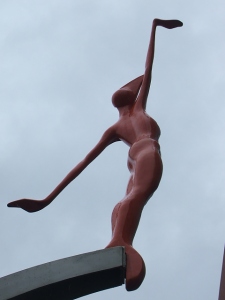Clinging To Cliffs: NWCDTP Conference 2015 Sketch (Pete Kalu)
You are hanging on to the cliff face by your fingertips. What to do? Luckily you were at the NWCDTP Conference 2015 and so you know you have options. You recall the sessions and they influence you in ways both oblique and direct:
Feel with your feet, perhaps there are giant shoulders underfoot: Joyce stood on the shoulders of the giant, Milton.
Inspiration: Renata Meints Adail: James Joyce’s Literary Revolution and his response to John Milton’s presence
Reverse brainstorm the problem: how would you manage to create this problem, what steps would you need to take? Now reverse this into a solution perhaps also by challenging some assumptions such as the assumption that the cliff is sheer – have a look down, you’ve been avoiding that, haven’t you? Is it really so sheer?
Inspiration: Tuesday afternoon exercise in problem solving
Many have been hanging to cliffs by their fingertips before, if you are caught up in the actions of a repressive State, what has been the way of resistance in the past: can the texts of Soyinka or Hajar Churashir Maa help, or the lessons from Haiti 1915-16?
Inspiration: Narratives of State Repression and Resistance panel subjects
Would you say your experience of hanging on by your fingertips is an experience (e1) that could be shared not only by person 1 (p1) but also by (p2)? Or is this an experience that is essentially incommunicable to others? Would you characterise your predicament as epistemological (we cannot know another person’s experiences) or ontological (such experiences cannot be felt by more than one subject)?
Further, is the experience of hanging by your fingertips one that conforms with the essentials of a unified consciousness or is there the possibility that your situation as you understood it is only a partial reality and that actually eg. you are dreaming or obtaining only a partial understanding of the reality? To expand, is the experience phenomenally unified, or is it merely the representational report of one side of the brain?
Inspiration: Exploring Experience and Perception panel
Is the dramatic element of hanging by your fingertips better expressed by a disordering of syntax and form such that the partial sentence ‘hanging by your fingertips’ may be aesthetically optimised via a subtle decay and deselection technique eg:
Hang hnging
ing tip
finger
ti psps
F
F
I
L
C
The above pasted with ordnance survey map of location, Mountain Rescue Incident Report including number, Last Will & Testament extract etc.
Inspiration: Reflecting on Creative Practices / Alan Beattie: Six timescapes: poetic experiments in kinesthetic empathy
Is the cliff properly separated from the subject – to state you are hanging by your fingertips from a cliff promotes the idea of cliff and self being separate entities. Does it not require the presence of the subject in the proximity of the sensory phenomena that constitute cliff for cliff to be properly considered to be in existence? If so, far from (or as well as) hanging onto the cliff, we carry the cliff within us.
Inspiration: Jan Barbara Fyfe: The Phenomenology or Perception within the Photographed Garden
Is the use of fingertips within the partial sentence not indicative of the need for greater editorial / mentor input , the phrase by itself being somewhat cliché and the moment better expressed (and melodrama avoided) by a tighter focus on the nature of those fingertips in a more realist style eg ‘when the last fingertip split I knew me and the damn stone were finished. It had been good, but everything ends.’
Inspiration: Jonathon Pountney: Carveresque Realism: How Raymond Carver Shaped the Early career of Jay McInerney
The sentence ‘you are hanging from your fingertips’ is the extant version in the official published text, chosen from a number of alternatives that were produced as part of the research-as-practice process. Rejected versions ‘I am hanging by my fingertips’ and ‘he was hanging by his fingertips’ were essential parts of this process and will feature within the critical commentary as part of exegesis.
Inspiration: Lauren Bolger: Abandoned Poems from ‘4.23pm, relaxant’
All the above remind me, I chose to be on this cliff, I have rope, there is a way down as well as up. It’s all cool. Relax, enjoy the view!
Moving beyond the metaphor, I enjoyed listening to the wide range of papers and absorbing the different styles and tones of presentation. These included curious, plaintive, admiring, commanding, erudite, joyous, baffled, hesitant and most stops in between. Those Creative Writing researchers whose papers I caught all proved phenomenal (colloquial use, not phenomenology use – rest up Gregory Miller!) in their highly different ways: their thoughtfulness, openness, and willingness to convey and share vulnerability were inspirational.
I will admit to being skeptical about the exercises for getting past PhD problems – SWOT and SMART two of the acronyms projected onto the screens are exercises I usually flee from at earliest opportunity. But the work in pairs proved fun and my partner led me to a moment of insight that was startlingly useful. Let’s do it again!


0 Comments